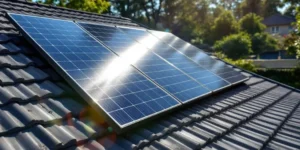How Much Power Does Solar Energy Produce?
A typical home solar panel generates 250–400 watts in direct sunlight, with newer models commonly hitting 400 watts. Actual production depends on factors like location, panel angle, and sunlight hours.
Key Takeaways
- Output Range: 250–400 watts per hour per panel, with most new panels at 400 watts.
- Daily Energy Example: A 400-watt panel in California makes about 1.6 kWh daily or 600 kWh yearly.
- Large Systems: A standard 10 kW system with 25 panels can generate 15,000 kWh annually, exceeding the average U.S. home’s yearly usage.
- Installation Angle: South-facing roofs at a 30° tilt capture the most sunlight.
- Cost and Savings: A 7 kW system often costs around $13,769 after tax credits, reducing bills by up to 70% and saving $31,982 over time.

How Much Energy Does a Solar Panel Produce?

How Much Energy Does One Solar Panel Produce?
Most panels today produce 350–450 watts. A 400-watt model in a sunny region like California can generate about 1.6 kWh daily (600 kWh yearly). Factors like peak sun hours, local climate, and panel efficiency influence these totals.
Factors Affecting Solar Panel Output
- Sunlight Hours: Panels need 4–6 peak sun hours daily for optimal performance.
- Roof Orientation: South-facing panels often produce 15% more than east- or west-facing ones.
- Weather: Cloud cover can reduce output by 10–25%.
- Temperature: Extremely hot days may lower efficiency by 10–25%.
- Panel Age: Power decreases by about 0.5–1% annually.
- Shade and Dirt: Even small shadows or debris can cut output by 25–35%.
- Panel Type: Monocrystalline typically converts 15–22% of sunlight, while polycrystalline averages 13–17%.
- Installation Angle: A 30–45° tilt usually maximizes output.
- Maintenance: Cleaning dirty panels restores 5% or more of lost power.
Calculating Solar Panel Wattage
To find a panel’s wattage, multiply volts by amps (Watts = Volts × Amps). A 400-watt panel with a 1.5 production ratio yields about 600 kWh yearly. Larger systems often use multiple panels to meet higher energy demands.
How Much Energy Can a Solar System Produce?
A 10 kW setup (25 panels at 400 watts each) can produce around 15,000 kWh per year—more than enough for the average U.S. home. Smaller systems, like 7 kW, may still offset a substantial portion of monthly bills. Solar costs vary by region, but a 7 kW system often saves thousands over its lifespan.
Maximizing Efficiency
- Ideal Placement: South-facing roof, 30° angle.
- Regular Cleaning: Removes dust and debris every few months.
- Air Circulation: Install panels slightly above the roof to reduce heat buildup.
- High-Efficiency Panels: Monocrystalline options and PERC technology can boost output.
- Monitor Performance: Use inverter apps or power meters to spot issues early.
- Power Optimizers: Maintain efficiency when parts of the array are shaded.
FAQs
- How much power do residential solar panels produce?
Typical output ranges from 250–400 watts per hour per panel. Factors like peak sun hours and panel efficiency affect actual generation. - What influences solar panel efficiency the most?
Orientation, shade, temperature, and panel technology all play significant roles. - Do solar panels meet entire home energy needs?
A suitably sized system can cover most or all of a household’s electricity demands. - What’s the difference between kilowatts and kilowatt-hours?
Kilowatts (kW) measure instantaneous power capacity, while kilowatt-hours (kWh) track energy produced or consumed over time. - Can solar panels charge an electric vehicle?
Yes. You’ll need enough panels to meet household consumption plus EV charging requirements. - How long before a solar system pays for itself?
Most systems recoup costs in 5–10 years, depending on local rates, tax credits, and net metering benefits.





